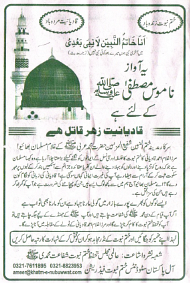Pakistan |
Ahmadis under attack: In Rabwah, every house has a story to tell
By Saba Imtiaz
Published: July 12, 2011
Published: July 12, 2011
 The tombstones in Rabwah's graveyards tell a macabre tale. PHOTO: SABA IMTIAZ/EXPRESS |
RABWAH: The tombstones in Rabwah’s graveyards tell a macabre tale. The graves of the men killed in the attacks on Ahmadi places of worship in Lahore – retired army officers and young factory workers among them – rest with the dozens killed due to the persecution of the Ahmadiyya community.
The graveyards have been defiled in the past as locals have released animals in the graveyards or trod on the graves.
Other tombstones in a row show how entire families were systematically killed.
“If you knock at any door in Rabwah, you will find a story of persecution,” says Amir Mahmood, who works at the Jamaat Ahmadiyya’s press section.
One door leads to a prominent Ahmadi family from Mardan. Despite years of harassment, lawsuits, imprisonment and a kidnapping, the family’s men vowed to stay in Mardan. Four of them were gunned down. “After my father’s assassination I told my husband to be more careful. But he wasn’t scared,” says Rabia Mehmood, who was expecting her first child when her husband was killed.
Another door leads to Bushra Siddiqui’s family. She lives with her two widowed daughters, whose husbands were killed because of their faith.
Siddiqui’s daughter Asma Ahsan says her husband was praying at Darul Zikr in Lahore when it was besieged last May. She received a phone call from him, informing her that he was safe. Later, she learned that he had been killed. To add insult to injury, several neighbours did not offer condolences.
While the May 2010 carnage highlighted the systematic campaign of violence against Ahmadis, it did not end there. Three days later, a man entered Naimatullah’s house in Narowal district and stabbed him to death. His daughter Sidra recalls waking up to an “awful noise”. She rushed to the courtyard, where her dying father lay. The assassin was caught a few hours later, roaming around a seminary after Fajr prayers. He was reportedly ‘inspired’ to kill Naimutallah after being incited by local clerics.
“Nobody is safe in this country,” says Malik Munawwar Ahmad, the 78-year-old head of Darul Ziafat, which carries out the decades-old tradition in the community of housing and feeding travellers.
For Ahmadis, every day brings forth new incidents of harassment. In Vehari, clerics recently called for the Kalima to be erased from Ahmadi places of worship. The Jamaat’s representative in Vehari says the threat – from the Khatam-e-Nabuwwat movement and the Majlis-e-Ahrar – emanated from a land dispute over an Ahle Hadith mosque, which was unrelated to the Ahmadiyya community. He said the community would not give in to the clerics’ threats and would wait for the area administration’s decision.
“There was always opposition to us, but the 1974 and 1984 amendments created a storm,” says Ahmad. “But our silent protest is being recorded with God, and He will announce His decision.”
Published in The Express Tribune, July 12th, 2011.
The graveyards have been defiled in the past as locals have released animals in the graveyards or trod on the graves.
Other tombstones in a row show how entire families were systematically killed.
“If you knock at any door in Rabwah, you will find a story of persecution,” says Amir Mahmood, who works at the Jamaat Ahmadiyya’s press section.
One door leads to a prominent Ahmadi family from Mardan. Despite years of harassment, lawsuits, imprisonment and a kidnapping, the family’s men vowed to stay in Mardan. Four of them were gunned down. “After my father’s assassination I told my husband to be more careful. But he wasn’t scared,” says Rabia Mehmood, who was expecting her first child when her husband was killed.
Another door leads to Bushra Siddiqui’s family. She lives with her two widowed daughters, whose husbands were killed because of their faith.
Siddiqui’s daughter Asma Ahsan says her husband was praying at Darul Zikr in Lahore when it was besieged last May. She received a phone call from him, informing her that he was safe. Later, she learned that he had been killed. To add insult to injury, several neighbours did not offer condolences.
While the May 2010 carnage highlighted the systematic campaign of violence against Ahmadis, it did not end there. Three days later, a man entered Naimatullah’s house in Narowal district and stabbed him to death. His daughter Sidra recalls waking up to an “awful noise”. She rushed to the courtyard, where her dying father lay. The assassin was caught a few hours later, roaming around a seminary after Fajr prayers. He was reportedly ‘inspired’ to kill Naimutallah after being incited by local clerics.
“Nobody is safe in this country,” says Malik Munawwar Ahmad, the 78-year-old head of Darul Ziafat, which carries out the decades-old tradition in the community of housing and feeding travellers.
For Ahmadis, every day brings forth new incidents of harassment. In Vehari, clerics recently called for the Kalima to be erased from Ahmadi places of worship. The Jamaat’s representative in Vehari says the threat – from the Khatam-e-Nabuwwat movement and the Majlis-e-Ahrar – emanated from a land dispute over an Ahle Hadith mosque, which was unrelated to the Ahmadiyya community. He said the community would not give in to the clerics’ threats and would wait for the area administration’s decision.
“There was always opposition to us, but the 1974 and 1984 amendments created a storm,” says Ahmad. “But our silent protest is being recorded with God, and He will announce His decision.”
Published in The Express Tribune, July 12th, 2011.
Copyrighted © 2011 The Express Tribune News Network
URL: http://tribune.com.pk/story/207776/ahmadis...to-tell/
URL: http://tribune.com.pk/story/207776/ahmadis...to-tell/




